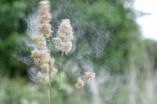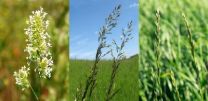(Press-News.org) Atishoo! Help, there are flowering grasses around, please stay indoors – while your friends enjoy the nice summer weather! Traditionally, people allergic to grass pollen are advised to be aware of high pollen concentrations during the day, and to reduce their outdoor activities during this period.
A new study led by researchers from Aarhus University shows that it is considerably more complicated to avoid grass pollen. Based on a three-year study with intensive measurements at three different locations in Aarhus, they divide the grass pollen season into three periods, as shown in the graph below: a twin peak profile during the early season, a single evening profile in the middle season and a single midday profile during the late season.
How should people react to these complicated patterns? Dr. Robert Peel, Aarhus University, explains:
"People should avoid being outdoors during the peak hours in periods one and two, especially between 16 and 20. Later in the summer, allergy sufferers should avoid being outdoor in the middle of the day."
Different species have different patterns
Concentrations of grass pollen are influenced by many factors, the most important being the weather and the emissions, which again depends on the grass species. In Denmark alone, 230 species of grass (atishoo!) have been recorded, of which around 20 species are likely to be particularly common in urban environments. The emission of pollen from the individual species is driven by different weather parameters, e.g. the temperature on the previous day or on the current day, some emissions stop when it is raining, others release their pollen in response to rain. Each species flowers intensively for approximately one-two weeks, and the total season is around two months. So no wonder, the patterns of grass pollen are complicated. But in general, people react more or less in the same manner to the pollen of all grasses growing in Denmark – and you cannot distinguish the species when counting pollen under a microscope.
Even though the information of the exact species present in the monitored area and pollen release patterns of the individual species are far from complete, Peel and his colleagues conclude that the best way to explain the three concentration patterns is to look at the succession of different grass species with different diurnal flowering patterns which dominate the atmospheric pollen loads as the season progresses.
INFORMATION:
The study was performed in collaboration with colleagues from the universities of Worcester, Vienna, Roskilde and the Astma-Allergy Association Denmark.
Photo Photo Photo
Latin name Dactylis glomerata Arrhenatherum elatius Lolium perenne
English name(s) Cock's-foot or orchard grass False oat-grass, tall oat-grass, tall meadow oat, onion couch and tuber oat-grass Perennial ryegrass or English ryegrass or winter ryegrass
Danish name Hundegræs (Alm.) draphavre Alm. rajgræs
Season Early flowering Middle (-late) Late
Diurnal pattern Morning peak Twin peak Midday peak
Photo panel:
Examples of grass species likely to be particularly common in Aarhus with different diurnal flowering patterns. The scientists conclude that the best way to explain the three diurnal concentration patterns is to look at the succession of different grass species with different diurnal flowering patterns throughout the season.
Further information
Dr. Robert G. Peel, Department of Environmental Science, Aarhus University, tel. +45 87 15 85 95, rp@dmu.dk
Seasonal variation in diurnal atmospheric grass pollen concentration profiles. R.G. Peel et al., Biogeosciences 11 (2014), 821-832. Doi:10.5194/bg-11-821/2014, http://www.biogeosciences.net/11/821/2014/bg-11-821-2014-metrics.ht
Scientists map the worst times of day for people allergic to grass pollen
Based on their results, the researchers provide new advices to allergy sufferers
2014-05-27
ELSE PRESS RELEASES FROM THIS DATE:
Sperm cells are extremely efficient at swimming against a current
2014-05-27
Like salmon traveling upstream to spawn, sperm cells are extremely efficient at swimming against the current, according to research to be published this week.
The discovery, to be published in the journal eLife by researchers at MIT and Cambridge University, may help us to understand how some sperm travel such long distances, through difficult terrain, to reach and fertilize an egg.
Of the hundreds of millions of sperm cells that begin the journey up the oviducts, only a few hardy travelers will ever reach their destination. Not only do the cells have to swim in the ...
Attack is not always the best defense
2014-05-27
Jena (Germany) It is something like the police force of our body: the immune system. It disables intruding pathogens, it dismantles injured tissue and boosts wound healing. In this form of 'self-defense' inflammatory reactions play a decisive role. But sometimes the body's defense mechanism gets out of control and cells or tissues are affected: "Then excessive reactions can occur and illnesses along with them," Prof. Dr. Oliver Werz of the Friedrich Schiller University Jena says. He gives asthma, rheumatism, arteriosclerosis and cancer as examples: "For many of these diseases ...
The secret cargo of mosquitoes
2014-05-27
The parasite Dirofilaria repens is a roundworm that primarily attacks the subcutaneous tissue of dogs and causes lumps in the skin, swelling, and itching. Dogs, cats, foxes, wolves and martens can be infected in addition to dogs. "In humans, 16 cases of human dirofilariosis have been recorded since the year 2000, but the dark figure is definitely higher", says the lead author Katja Silbermayr. Humans, however, are so-called dead end hosts; the parasite does not reproduce in humans and therefore poses no major risk.
Silbermayr is a veterinarian and performs research on ...
Seeing e-cigarette use encourages young adult tobacco users to light up
2014-05-27
VIDEO:
"Whether participants were exposed to someone smoking a combustible or an e-cigarette, the urge to smoke a combustible cigarette was just as high in either condition, " King said. "If the...
Click here for more information.
Seeing people use electronic cigarettes (e-cigarettes) increases the urge to smoke among regular combustible cigarettes users, according to a new study of young adult smokers. This elevated desire is as strong as when observing someone ...
Stanford researchers discover immune system's rules of engagement
2014-05-27
A study led by researchers at Stanford's School of Medicine reveals how T cells, the immune system's foot soldiers, respond to an enormous number of potential health threats.
X-ray studies at the Department of Energy's SLAC National Accelerator Laboratory, combined with Stanford biological studies and computational analysis, revealed remarkable similarities in the structure of binding sites, which allow a given T cell to recognize many different invaders that provoke an immune response.
The research demonstrates a faster, more reliable way to identify large numbers ...
Climate change accelerates hybridization between native and invasive species of trout
2014-05-27
BOZEMAN, Mont. – Scientists have discovered that the rapid spread of hybridization between a native species and an invasive species of trout in the wild is strongly linked to changes in climate.
In the study, stream temperature warming over the past several decades and decreases in spring flow over the same time period contributed to the spread of hybridization between native westslope cutthroat trout and introduced rainbow trout – the world's most widely introduced invasive fish species –across the Flathead River system in Montana and British Columbia, Canada.
Experts ...
New perspectives to the design of molecular cages
2014-05-27
Researchers from the University of Jyväskylä report a new method of building molecular cages. The method involves the exploitation of intermolecular steric effects to control the outcome of a self-assembly reaction.
Molecular cages are composed of organic molecules (ligands) which are bound to metal ions during a self-assembly process. Depending on the prevailing conditions, self-assembly processes urge to maximize the symmetry of the system and thus occupy every required metal binding site. The research group led by docent Manu Lahtinen (University of Jyväskylä, Department ...
Molecules do the triple twist
2014-05-27
An international research team led by Academy Professor Kari Rissanen of the University of Jyväskylä (Finland) and Professor Rainer Herges of the University of Kiel (Germany) has managed to make a triple-Möbius annulene, the most twisted fully conjugated molecule to date, as reported in Nature Chemistry (DOI:10.1038/nchem.1955, published online 25 May 2014).
An everyday analogue of a single twisted Möbius molecule is a Möbius strip. It can be made easily by twisting one end of a paper strip by 180 degrees and then joining the two ends. A triple twisted Möbius molecule ...
Insights into genetics of cleft lip
2014-05-27
Scientists at the European Molecular Biology Laboratory (EMBL) in Heidelberg, have identified how a specific stretch of DNA controls far-off genes to influence the formation of the face. The study, published today in Nature Genetics, helps understand the genetic causes of cleft lip and cleft palate, which are among the most common congenital malformations in humans.
"This genomic region ultimately controls genes which determine how to build a face and genes which produce the basic materials needed to execute this plan", says François Spitz from EMBL, who led the work. ...
Clinical trial reaffirms diet beverages play positive role in weight loss
2014-05-27
May 27, 2014 – A groundbreaking new study published today in Obesity, the journal of The Obesity Society, confirms definitively that drinking diet beverages helps people lose weight.
"This study clearly demonstrates that diet beverages can in fact help people lose weight, directly countering myths in recent years that suggest the opposite effect – weight gain," said James O. Hill, Ph.D., executive director of the University of Colorado Anschutz Health and Wellness Center and a co-author of the study. "In fact, those who drank diet beverages lost more weight and reported ...
LAST 30 PRESS RELEASES:
This new understanding of T cell receptors may improve cancer immunotherapies
A new fossil face sheds light on early migrations of ancient human ancestor
A new immunotherapy approach could work for many types of cancer
A new way to diagnose deadly lung infections and save lives
40 percent of MRI signals do not correspond to actual brain activity
How brain-inspired algorithms could drive down AI energy costs
Gum disease may be linked to plaque buildup in arteries, higher risk of major CVD events
Contrails are a major driver of aviation’s climate impact
Structure of dopamine-releasing neurons relates to the type of circuits they form for smell-processing
Reducing social isolation protects the brain in later life
Keeping the heart healthy increases longevity even after cancer
Young adults commonly mix cannabis with nicotine and tobacco
Comprehensive review illuminates tau protein's dual nature in brain health, disease, and emerging psychiatric connections
Book prepares K-12 leaders for the next public health crisis
Storms in the Southern Ocean mitigates global warming
Seals on the move: Research reveals key data for offshore development and international ecology
Sports injuries sustained during your period might be more severe
World's first successful 2 Tbit/s free-space optical communication using small optical terminals mountable on satellites and HAPS
Can intimate relationships affect your heart? New study says ‘yes’
Scalable and healable gradient textiles for multi‑scenario radiative cooling via bicomponent blow spinning
Research shows informed traders never let a good climate crisis go to waste
Intelligent XGBoost framework enhances asphalt pavement skid resistance assessment
Dual-function biomaterials for postoperative osteosarcoma: Tumor suppression and bone regeneration
New framework reveals where transport emissions concentrate in Singapore
NTP-enhanced lattice oxygen activation in Ce-Co catalysts for low-temperature soot combustion
Synergistic interface engineering in Cu-Zn-Ce catalysts for efficient CO2 hydrogenation to methanol
COVID-19 leaves a lasting mark on the human brain
Scientists use ultrasound to soften and treat cancer tumors without damaging healthy tissue
Community swimming program for Black youth boosts skills, sense of belonging, study finds
Specific depressive symptoms in midlife linked to increased dementia risk
[Press-News.org] Scientists map the worst times of day for people allergic to grass pollenBased on their results, the researchers provide new advices to allergy sufferers






